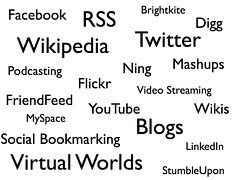 Yesterday I gave three talks. In the morning, I gave a relatively standard “Social Media 101” keynote at DocTrain West (thanks for having me, Scott). Anne posted her notes from that talk.
Yesterday I gave three talks. In the morning, I gave a relatively standard “Social Media 101” keynote at DocTrain West (thanks for having me, Scott). Anne posted her notes from that talk.
As I’ve said before, I like to keep my accompanying slides bullet point-free. On each slide, you either get an image, a diagram or a few words per slide. Here are my slides from yesterday’s talk, which are pretty much inscrutable without, well, me.
Why do I take that approach?
- It ensures that I’ve written a speech or at least an outline outside of the slides. I’ve said this before too, but just because you’ve made slides doesn’t mean you’ve written a speech.
- Images become metaphors, and metaphors are excellent teaching tools. I’m currently reading the excellent Made to Stick, and the authors are constantly reinforcing this idea.
- My slides look different from nearly everybody else’s. That makes me (and hopefully my ideas) more memorable. Lots of my fellow speaker had terrific ideas, but their slides were, for the most part, banal and full of bullet points. See for yourself. Remember, your slides are your costumes, lighting and set. So do them up nice.
- I try to pick beautiful photos. They’re a pleasure to look at. Even if audience members couldn’t care less about my talk, at least there’s something visually interesting going on.
After my talk somebody thanked me for being a bullet point-free zone.
Casual, Friendly and Open
In the afternoon, I was running a workshop on social media tools, channels and technology. It was towards the end of the last day of the conference, and I figured everybody would be a bit bored of PowerPoint presentations.
Instead, I prepared an informal, conversational session around this tag cloud:
As I explain in the talk, I’m actually cheating here. The size of the terms have no application. It’s just a fun, topical way to make a list. The subtextual message is casual, friendly and open.
Sometimes I print these tag clouds out, as in the above photo. Props are usually a good thing, and it’s always fun to have something to wave around.
I put this list up on the screen, and invite people to ask about any of the terms, or to tell stories about their experiences. I prepare by devising little riffs and case study on each term.
It’s certainly not a particularly original or innovative approach, but I find people respond to it in a workshop or other less formal session. The tag cloud provides just enough structure to keep the conversation on track, and enables me to refocus or refresh the topic as necessary.
Plus, it’s more fun for me. I get to learn more from the audience, and the randomness of it keeps me on my toes. In a way, it’s a kind of rip-off of 30 Plays in 60 Minutes.
UPDATE: I wrote this post partially because James sent me these guidelines for abstract pointillism in PowerPoint.

It’s about time I added a new link to my PowerPoint tips page. Thanks.
When I came more than to this post I can only appear at part of it, is this my net browser or the internet web site? Should I reboot?